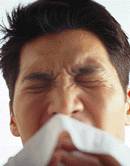Different patterns of disease association seen for CRS with or without nasal polyps
TUESDAY, Sept. 8, 2015 (HealthDay News) — Chronic rhinosinusitis (CRS) is associated with increased risk of other diseases, with different patterns based on CRS phenotype, according to research published online Aug. 31 in Allergy.
Annemarie G. Hirsch, Ph.D., M.P.H., from the Geisinger Health System in Danville, Pa., and colleagues examined the risk of incident disease within five years after a new diagnosis of CRS with nasal polyps (CRSwNP) and without nasal polyps (CRSsNP). Data were included from a case-control study nested within a longitudinal cohort of primary care patients.
The researchers found that, compared with controls, the 3,612 CRSsNP cases had increased risk for incidence of upper airway diseases, including adenotonsillitis (hazard ratio [HR], 3.29); lower aerodigestive tract disease, including asthma (HR, 2.69); epithelial conditions, including atopic dermatitis (HR, 2.75); and hypertension (HR, 1.38). Compared with controls, the 241 CRSwNP cases had increased risk for obesity (HR, 1.74); there was no correlation for CRSwNP with other diseases.
“The risk of other diseases associated with CRS adds to the burden of an already highly burdensome condition, and suggests either that CRS promotes onset of other diseases or is an indicator of systemic disease processes,” the authors write.
Copyright © 2015 HealthDay. All rights reserved.








